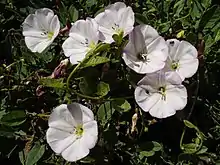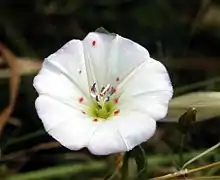Convolvulus arvensis
Convolvulus arvensis (field bindweed) is a species of bindweed that is rhizomatous and is in the morning glory family (Convolvulaceae),[1] native to Europe and Asia. It is a climbing or creeping herbaceous perennial plant growing to 0.5–2 m high. There are two varieties:
- Convolvulus arvensis var. arvensis. Leaves broader.
- Convolvulus arvensis var. linearifolius. Leaves narrower.
| Field bindweed | |
|---|---|
 | |
| Scientific classification | |
| Kingdom: | Plantae |
| Clade: | Tracheophytes |
| Clade: | Angiosperms |
| Clade: | Eudicots |
| Clade: | Asterids |
| Order: | Solanales |
| Family: | Convolvulaceae |
| Genus: | Convolvulus |
| Species: | C. arvensis |
| Binomial name | |
| Convolvulus arvensis | |
Other common names, mostly obsolete, include lesser bindweed, European bindweed, withy wind (in basket willow crops), perennial morning glory, small-flowered morning glory, creeping jenny, and possession vine.
Description
The leaves are spirally arranged, linear to arrowhead-shaped, 2–5 cm long and alternate, with a 1–3 cm petiole. The flowers are trumpet-shaped, 1–2.5 cm diameter, white or pale pink, with five slightly darker pink radial stripes. Flowering occurs in the mid-summer, when white to pale pink, funnel-shaped flowers develop. Flowers are approximately 0.75–1 in (1.9–2.5 cm) across and are subtended by small bracts. Fruit are light brown, rounded and 0.125 inches (3.2 mm) wide. Each fruit contains 2 seeds that are eaten by birds and can remain viable in the soil for decades. The stems climb by twisting around other plant stems in a counterclockwise direction.[2]



Although it produces attractive flowers, it is often unwelcome in gardens as a nuisance weed due to its rapid growth and choking of cultivated plants. It was most likely introduced into North America as a contaminant in crop seed as early as 1739, as an invasive species. Plants typically inhabit roadsides, grasslands and also along streams. Its dense mats invade agricultural fields and reduce crop yields; it is estimated that crop losses due to this plant in the United States exceeded US$377 million in the year 1998 alone.[3]
In one of the tales collected by Jacob and Wilhelm Grimm, Our Lady's Little Glass, this flower is used by Mary, mother of Jesus, to drink wine with when she helps free a wagoner's cart. The story goes on to say that "the little flower is still always called Our Lady's Little Glass."
Ecological impacts
Field bindweed intertwines and topples native species. It competes with other species for sunlight, moisture and nutrients. It poses threats to restoration efforts and riparian corridors by choking out grasses and forbs. It can decrease habitat biodiversity and is one of the most serious weeds of agricultural fields in temperate regions of the world.
Toxicity
Bindweed contains several alkaloids, including pseudotropine, and lesser amounts of tropine, tropinone, and meso-cuscohygrine.[4]
Control and management
Bindweed is difficult to eliminate. Roots may extend as far as nine feet deep, according to one source,[5] or 30 feet, according to another.[6] New plants may sprout from seeds that are up to 20 years old.[7] New plants can also form from root runners[6] and root fragments.[5]
Methods for controlling bindweed include:
- Physical removal: Bindweed can be controlled by pulling it out by hand or plowing it up every three weeks[5] for up to seven years.[6]
- Mulching: Applying a barrier to block sun may control bindweed. Black plastic, landscape fabric or cardboard covered with a layer of mulch will prevent light from reaching the bindweed.[6] The light-blocking material must be maintained for up to five years. Plants that emerge on the edges of the covered area must be removed.
- Biological control: Some insects and mites can eat, distort or stunt bindweed, but do not fully control it.[8]
References
- Parnell, J. and Curtis, T. 2012. Webb's An Irish Flora. Cork University Press. ISBN 978-185918-4783
- Clapham, A.R., Tutin, T.G. and Warburg, E.F. 1968 Excursion Flora of the British Isles Second Edition Cambridge University Press.ISBN 0-521-04656-4
- Coombs, E. M., et al., Eds. (2004). Biological Control of Invasive Plants in the United States. Corvallis: Oregon State University Press, 151.
- Vet Hum Toxicol. 1995 Oct;37(5):452-4. Toxicity of field bindweed (Convolvulus arvensis) to mice. Schultheiss PC1, Knight AP, Traub-Dargatz JL, Todd FG, Stermitz FR.
- "Bidding Farewell to the Dreaded Bindweed". Oregon State University Extension Service. September 2008. Archived from the original on 16 July 2019.
- Beddes, Taun (24 September 2014). "Tips on Controlling Bindweed". Utah State University Extension. Archived from the original on 16 July 2019.
- USDA Forest Service. "Weed of the Week: Field Bindweed" (PDF). Archived from the original (PDF) on 16 July 2019.
- Cortat, Ghislaine (15 November 2018). "Convolvulus arvensis (bindweed)". Invasive Species Compendium. CAB International. Archived from the original on 16 July 2019.
- Blanchan, Neltje (2002). Wild Flowers: An Aid to Knowledge of Our Wild Flowers and Their Insect Visitors. Project Gutenberg Literary Archive Foundation.
- Flora Europaea: Convolvulus arvensis
- Flora of China: Convolvulus arvensis
- Invasive.org: Convolvulus arvensis
- PLANTS Profile: Convolvulus arvensis (field blindweed) | USDA PLANTS
- Invasive Plants of Asia Origin Established in the US and their Natural Enemies p. 58–59
- WSSA-1,000 Weeds of North America: An Identification Guide
- Federal Noxious Weed Disseminules in the US